I'm taking a break from regular posting on this blog. I invite visits to my web site, and I'll continue to respond to emails on photography and vintage cameras.
Meanwhile, for an excellent illustrated account of the intricacies of getting aid to Haiti by air, see the Vintage Aeroplane Writer blog.
Friday, January 22, 2010
Tuesday, January 19, 2010
instant flirtation

A few years ago when we still lived in our home in the desert of southern New Mexico I bought several old polaroid cameras for about a buck each at the local Goodwill. My purpose was to use pieces of the mirrors in the cameras to restore the small reflex viewers in some of my old cameras. I think that, at the time, the Polaroid Corporation was about to go belly-up, and film packs were being offered at somewhat reduced prices. So, I picked up a pack and shot it around the house. I wasn't comfortable with the inexactitude of the process of making photos with the simple cameras, and the price was still too high. Looking at the images now, though, I rather like them and wish I could have talked myself into doing a few more.



Sunday, January 17, 2010
Saturday, January 16, 2010
borders and sprockets
I went to some trouble, as I described in my last post, to eliminate the sprocket holes from my Fed-1g images. On other occasions I have done just the opposite, incorporating into my images the film negative borders with their lettering and numerals or the sprocket holes from 35mm film. I think the first time I used this style was in an image made with my No.2 Folding Autographic Brownie. I decided I wanted a very large print to hang over my desk, so I took a scan of the image to a fellow in the Las Cruces downtown mall who had an Epson printer about two yards wide. As he was preparing the image for printing, I saw him start to crop out the film borders. I hastened to tell him I wanted the borders left in the print. He gave me a quizzical look, and I muttered something about the framing effect. So he proceeded as directed with only a slight curl of the lip.
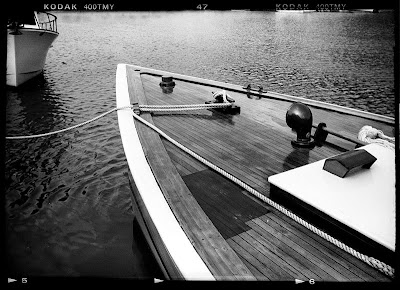
Kodak No.2 Folding Autographic Brownie
It is not immediately apparent to everyone why including the film borders and sprocket holes into an image is a good idea. I think the creation of a natural framing device is part of the appeal. The border inclusion also calls attention to the photographic process and further differentiates the image from those created by other means such as painting or drawing.
In the case of my No.1A Autographic, the negative frame borders also document the panoramic format which results from using 120 film in an old 116-format camera.
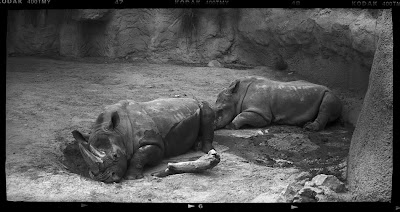
Kodak No.1A Folding Pocket Special
I think another aspect of appeal in the use of negative frame borders resides in a declaration of authenticity. One sees that the entire image recorded by the film is displayed with no cropping. I'm usually perfectly willing to crop for compositional value, but it is nice to have an example or two from an old camera which clearly show the unaltered proportions of the images.
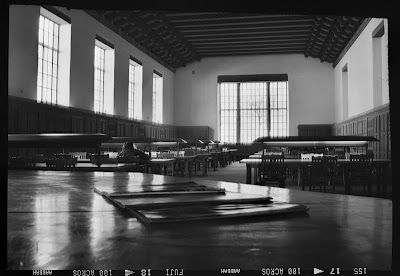
Ansco Folding Buster Brown
Negative frame borders are sometimes useful in identifying the type of camera that has made the image. For instance, the film holders for large-format cameras leave a very distinctive impression on the film. The upside-down lettering at the bottom of the images from both the Buster Brown and the Clack result from the fact that the advancing film travels from right to left.

Agfa Clack
The Certo Dolly is a particularly versatile shooter, offering two formats, 6x6 and 6x4.5, and one can further emphasize the proportional possibilities with inclusion of the frame borders in the images.
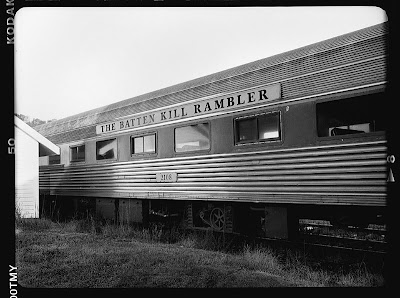
Certo Dolly Supersport, 6x4.5 mask
Although the Dolly is built to use 120 film, it is also easily possible to use 35mm film in the camera. The 35mm cartridge fits with no problem into the feed compartment. One needs to be careful to keep the ruby windows well covered with black tape, and it is necessary to advance the film blindly with a couple of turns each time to keep the frames separated. What you get with this technique is an image that extends out over the sprocket holes. In addition to the graphic interest this produces, I think it is also a useful way to help create a link between pictures in a series. An example of this can be seen in a roll from the Dolly shot along Route 66 in Albuquerque.
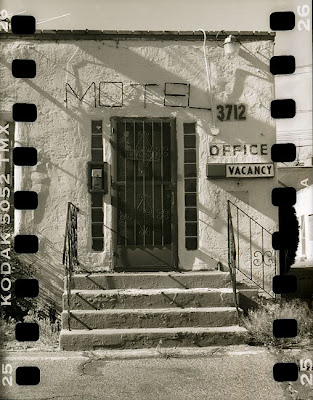
Certo Dolly Supersport, 35mm film

Kodak No.2 Folding Autographic Brownie
It is not immediately apparent to everyone why including the film borders and sprocket holes into an image is a good idea. I think the creation of a natural framing device is part of the appeal. The border inclusion also calls attention to the photographic process and further differentiates the image from those created by other means such as painting or drawing.
In the case of my No.1A Autographic, the negative frame borders also document the panoramic format which results from using 120 film in an old 116-format camera.

Kodak No.1A Folding Pocket Special
I think another aspect of appeal in the use of negative frame borders resides in a declaration of authenticity. One sees that the entire image recorded by the film is displayed with no cropping. I'm usually perfectly willing to crop for compositional value, but it is nice to have an example or two from an old camera which clearly show the unaltered proportions of the images.

Ansco Folding Buster Brown
Negative frame borders are sometimes useful in identifying the type of camera that has made the image. For instance, the film holders for large-format cameras leave a very distinctive impression on the film. The upside-down lettering at the bottom of the images from both the Buster Brown and the Clack result from the fact that the advancing film travels from right to left.

Agfa Clack
The Certo Dolly is a particularly versatile shooter, offering two formats, 6x6 and 6x4.5, and one can further emphasize the proportional possibilities with inclusion of the frame borders in the images.

Certo Dolly Supersport, 6x4.5 mask
Although the Dolly is built to use 120 film, it is also easily possible to use 35mm film in the camera. The 35mm cartridge fits with no problem into the feed compartment. One needs to be careful to keep the ruby windows well covered with black tape, and it is necessary to advance the film blindly with a couple of turns each time to keep the frames separated. What you get with this technique is an image that extends out over the sprocket holes. In addition to the graphic interest this produces, I think it is also a useful way to help create a link between pictures in a series. An example of this can be seen in a roll from the Dolly shot along Route 66 in Albuquerque.

Certo Dolly Supersport, 35mm film
Thursday, January 14, 2010
one cent camera repair

My Soviet Leica-copy Fed-1g has an accurate rangefinder and shutter, and a terrific Tessar-type lens. It also has an odd problem with film alignment. The sprocket holes intrude into the image area on one side of the frame. It may be a case of overly-generous manufacturing tolerances, or perhaps it is just that modern film cartridges don't quite fit the camera.

I was able to push the film cartridge down into the compartment and the film would track ok if I maintained some pressure. I decided that what I needed was a thin spacer to take up the extra space over the cartridge. It turned out that a penny fit perfectly in the available space.

Some post-fix images from this morning:

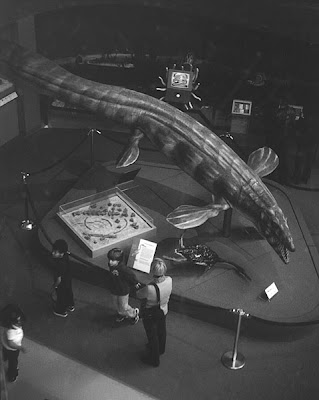


Saturday, January 09, 2010
more geese
Friday, January 08, 2010
Special
The Kodak No.1 Autographic Special is the most interesting camera in my collection. It was built about 1915 and represented the state of the art at the time in many respects. Few other cameras then had shutters like the dashpot-operated Optimo with speeds from 1 second to 1/300. The Bausch and Lomb Tessar, licensed from Zeiss, was recomputed to allow a fast f4.5 aperture. The camera's overall construction was of very high quality and included features that put it into the luxury class including a finely-textured sealskin covering. The resolution of the images from the lens combined with the 6cmx9cm format is astounding.


Shooting a 6x9 with no rangefinder is a challenge I haven't really mastered. I've found it generally a good idea to put the camera on a tripod and shoot at small apertures, so subjects that lend themselves to a slow and careful approach usually work out best.


To enhance my chances a bit more I also recently did a little work on the shutter, and I recollimated the lens. Setting the infinity focus is a little difficult on this camera. One has to loosen a screw that is beneath the flip-out tab on the cover, and then adjust the little stop button fore and aft in front of the lens mount.

I think I've got it right now, so we'll see if I can make some pictures that do justice to this fine old Kodak.


Shooting a 6x9 with no rangefinder is a challenge I haven't really mastered. I've found it generally a good idea to put the camera on a tripod and shoot at small apertures, so subjects that lend themselves to a slow and careful approach usually work out best.


To enhance my chances a bit more I also recently did a little work on the shutter, and I recollimated the lens. Setting the infinity focus is a little difficult on this camera. One has to loosen a screw that is beneath the flip-out tab on the cover, and then adjust the little stop button fore and aft in front of the lens mount.

I think I've got it right now, so we'll see if I can make some pictures that do justice to this fine old Kodak.
Wednesday, January 06, 2010
fun in the sun
Lief Peng's fine blog about Twentieth Century illustration this week is featuring the work of Al Dorne. The first example of the artist's work is a 1946 ad which includes an accurate representation of the Kodak 35 camera.

I have acquired three examples of the Kodak 35 over the years. One is the infamous rangefinder version which was cobbled together to compete with the Argus C3. The other two, shown below, are earlier scale-focus models.
The camera on the left with the accessory rangefinder has the Kodamatic shutter with speeds from 10 to 200 plus B and T, and the f3.5/50mm Kodak Anastigmat Special lens. The camera on the right has the No.1 Diomatic shutter with speeds from 25-150 plus B and T, and the f4.5/50mm Anastigmat lens. As can be seen in the sample photos posted on my web page about the Kodak 35, all are very capable performers.

The Anastigmat lens is a three-element design that was used on cameras made by nearly every manufacturer. As can be seen in the diagrams below, the Kodak Anastigmat Special is a four-elements-in-three-groups design very similar to the Tessar. The main difference seems to be the reversed orientation of the second and third groups. I don't know if there was any real advantage to the Kodak variation on the classic Zeiss Tessar design, but my own experience has shown it to compare very favorably with the great European classic lens.

The unusual appearance of the Kodak 35, reminiscent of the design of the company's medium-format cameras, is not immediately appealing to many classic camera enthusiasts, but it fits nicely in the hands and will produce excellent results if given the chance.

I have acquired three examples of the Kodak 35 over the years. One is the infamous rangefinder version which was cobbled together to compete with the Argus C3. The other two, shown below, are earlier scale-focus models.
The camera on the left with the accessory rangefinder has the Kodamatic shutter with speeds from 10 to 200 plus B and T, and the f3.5/50mm Kodak Anastigmat Special lens. The camera on the right has the No.1 Diomatic shutter with speeds from 25-150 plus B and T, and the f4.5/50mm Anastigmat lens. As can be seen in the sample photos posted on my web page about the Kodak 35, all are very capable performers.

The Anastigmat lens is a three-element design that was used on cameras made by nearly every manufacturer. As can be seen in the diagrams below, the Kodak Anastigmat Special is a four-elements-in-three-groups design very similar to the Tessar. The main difference seems to be the reversed orientation of the second and third groups. I don't know if there was any real advantage to the Kodak variation on the classic Zeiss Tessar design, but my own experience has shown it to compare very favorably with the great European classic lens.

The unusual appearance of the Kodak 35, reminiscent of the design of the company's medium-format cameras, is not immediately appealing to many classic camera enthusiasts, but it fits nicely in the hands and will produce excellent results if given the chance.
Tuesday, January 05, 2010
snowsuit
Monday, January 04, 2010
high tech

This picture of downtown Albuquerque was made last Fall. It was selected recently to appear in an Albuquerque City Guide application for the iPhone called "Schmaps".

Not one of my best shots of the city, perhaps, but it does have graphic qualities that suit it to display on a two-inch screen. I'm guessing it is also the only Schmaps photo made with a 1939 Argus A2F camera.
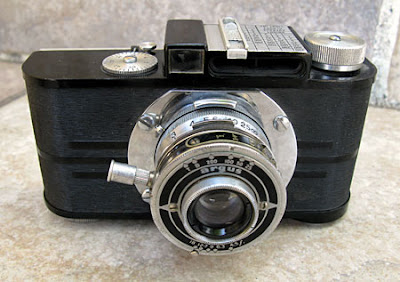
Sunday, January 03, 2010
Charles Fletcher Lummis
I walked over to the Albuquerque Museum this morning for a second look at a currently featured exhibit: Time Exposure; Picturing a History of the Isleta Pueblo in the 19th Century.

The show's highlight for me was an introduction to the work of C.F. Lummis, a journalist and editor, as well as a very accomplished early photographer of the Southwest. His prints do not have the technical sophistication of those from contemporaries like Vroman and Curtis, but they display great intimacy and authenticity due to the fact that Lummis lived for several years in the Isleta Pueblo, and the people portrayed were his friends. Lummis learned Spanish and Tiwa in the Pueblo, and he became a champion of Native American rights.
Most of the Lummis pictures in the exhibit are big enlargements from the original prints, most of which were blue-toned cyanotypes. Two exquisite original cyanotype contact prints were only visible under a glass case which contained an album he had assembled from his work in the late 1880s at Isleta.
Finding examples of Lummis' work on line is a challenge. They don't show up in search engine results because they are mostly contained within museum and library collections which can only be accessed through quirky institutional interfaces. The largest number of Lummis prints appear to be at the Autry National Center of the American West in Los Angeles. Below is a small selection of Lummis prints accessed through the site's "Research" tab.









The show's highlight for me was an introduction to the work of C.F. Lummis, a journalist and editor, as well as a very accomplished early photographer of the Southwest. His prints do not have the technical sophistication of those from contemporaries like Vroman and Curtis, but they display great intimacy and authenticity due to the fact that Lummis lived for several years in the Isleta Pueblo, and the people portrayed were his friends. Lummis learned Spanish and Tiwa in the Pueblo, and he became a champion of Native American rights.
Most of the Lummis pictures in the exhibit are big enlargements from the original prints, most of which were blue-toned cyanotypes. Two exquisite original cyanotype contact prints were only visible under a glass case which contained an album he had assembled from his work in the late 1880s at Isleta.
Finding examples of Lummis' work on line is a challenge. They don't show up in search engine results because they are mostly contained within museum and library collections which can only be accessed through quirky institutional interfaces. The largest number of Lummis prints appear to be at the Autry National Center of the American West in Los Angeles. Below is a small selection of Lummis prints accessed through the site's "Research" tab.








Subscribe to:
Posts (Atom)





